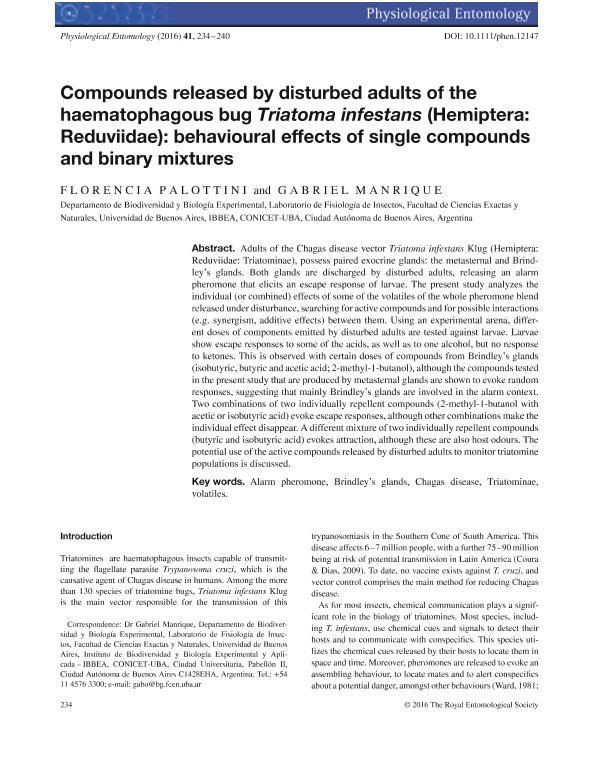Mostrar el registro sencillo del ítem
dc.contributor.author
Palottini, Florencia

dc.contributor.author
Manrique, Gabriel

dc.date.available
2018-09-14T19:16:42Z
dc.date.issued
2016-05
dc.identifier.citation
Palottini, Florencia; Manrique, Gabriel; Compounds released by disturbed adults of the haematophagous bug Triatoma infestans (Hemiptera: Reduviidae): behavioural effects of single compounds and binary mixtures; Wiley Blackwell Publishing, Inc; Physiological Entomology (print); 41; 3; 5-2016; 234-240
dc.identifier.issn
0307-6962
dc.identifier.uri
http://hdl.handle.net/11336/59777
dc.description.abstract
Adults of the Chagas disease vector Triatoma infestans Klug (Hemiptera: Reduviidae: Triatominae), possess paired exocrine glands: the metasternal and Brindley's glands. Both glands are discharged by disturbed adults, releasing an alarm pheromone that elicits an escape response of larvae. The present study analyzes the individual (or combined) effects of some of the volatiles of the whole pheromone blend released under disturbance, searching for active compounds and for possible interactions (e.g. synergism, additive effects) between them. Using an experimental arena, different doses of components emitted by disturbed adults are tested against larvae. Larvae show escape responses to some of the acids, as well as to one alcohol, but no response to ketones. This is observed with certain doses of compounds from Brindley's glands (isobutyric, butyric and acetic acid; 2‐methyl‐1‐butanol), although the compounds tested in the present study that are produced by metasternal glands are shown to evoke random responses, suggesting that mainly Brindley's glands are involved in the alarm context. Two combinations of two individually repellent compounds (2‐methyl‐1‐butanol with acetic or isobutyric acid) evoke escape responses, although other combinations make the individual effect disappear. A different mixture of two individually repellent compounds (butyric and isobutyric acid) evokes attraction, although these are also host odours. The potential use of the active compounds released by disturbed adults to monitor triatomine populations is discussed.
dc.format
application/pdf
dc.language.iso
eng
dc.publisher
Wiley Blackwell Publishing, Inc

dc.rights
info:eu-repo/semantics/openAccess
dc.rights.uri
https://creativecommons.org/licenses/by-nc-sa/2.5/ar/
dc.subject
Alarma Pheromone
dc.subject
Brindley&Acute;S Glands
dc.subject
Chagas Disease
dc.subject
Triatominae
dc.subject.classification
Otras Ciencias Biológicas

dc.subject.classification
Ciencias Biológicas

dc.subject.classification
CIENCIAS NATURALES Y EXACTAS

dc.title
Compounds released by disturbed adults of the haematophagous bug Triatoma infestans (Hemiptera: Reduviidae): behavioural effects of single compounds and binary mixtures
dc.type
info:eu-repo/semantics/article
dc.type
info:ar-repo/semantics/artículo
dc.type
info:eu-repo/semantics/publishedVersion
dc.date.updated
2018-09-14T13:24:39Z
dc.journal.volume
41
dc.journal.number
3
dc.journal.pagination
234-240
dc.journal.pais
Reino Unido

dc.journal.ciudad
Londres
dc.description.fil
Fil: Palottini, Florencia. Universidad de Buenos Aires. Facultad de Ciencias Exactas y Naturales. Departamento de Biodiversidad y Biología Experimental. Laboratorio de Fisiología de Insectos; Argentina. Consejo Nacional de Investigaciones Científicas y Técnicas; Argentina
dc.description.fil
Fil: Manrique, Gabriel. Universidad de Buenos Aires. Facultad de Ciencias Exactas y Naturales. Departamento de Biodiversidad y Biología Experimental. Laboratorio de Fisiología de Insectos; Argentina. Consejo Nacional de Investigaciones Científicas y Técnicas; Argentina
dc.journal.title
Physiological Entomology (print)

dc.relation.alternativeid
info:eu-repo/semantics/altIdentifier/doi/http://dx.doi.org/ 10.1111/phen.12147
dc.relation.alternativeid
info:eu-repo/semantics/altIdentifier/url/https://onlinelibrary.wiley.com/doi/abs/10.1111/phen.12147
Archivos asociados
